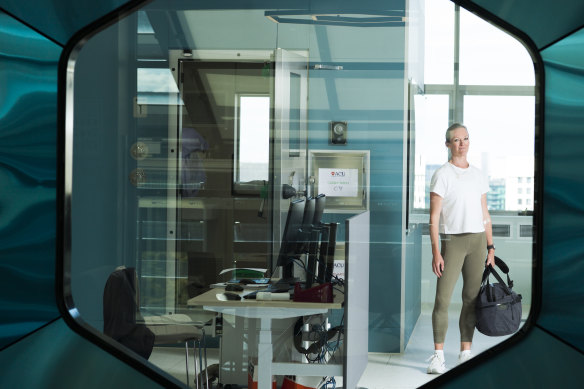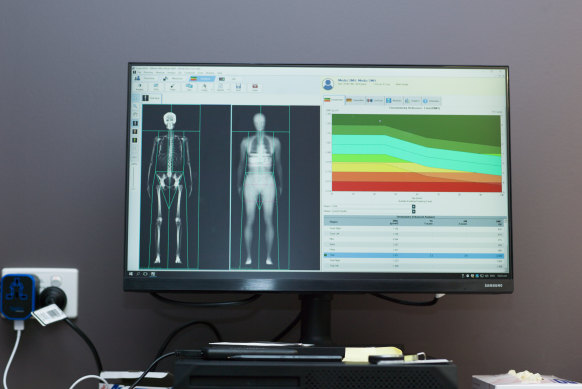This was published 3 months ago
‘A middle-aged lab rat’: 24 hours inside Australia’s first metabolic chamber
Being cooped inside a high-tech, airtight chamber may not be everyone’s idea of fun, but when it comes to our health and fitness, it’s the most exact device yet for unlocking the mysteries of our metabolism.
By Sarah Berry

Journalist Sarah Berry outside the metabolic chamber at the Australian Catholic University, Melbourne. Being inside it is like being on a plane to nowhere, she says, “yet I’m aware it could transport some people towards a new and healthier life.”Credit: Elke Meitzel
It’s a cool, grey morning in Melbourne’s Fitzroy, where I’ve just been locked inside a vacuum-sealed, temperature-controlled chamber, a lab rat for health data collection. For the next 24 hours, the minutiae of my metabolic inputs and outputs will be measured in real time while I live inside this two-by-three-metre room.
I will need to wee into a container (plumbing the toilet would compromise the seal of the room) and, god forbid, if I need to do a number two it will be instantly frozen in the plastic bag-lined loo to extinguish the odour. I will then suffer the indignity of passing the hazard bag to one of the researchers waiting outside, through a double-door waste-hatch.
As only the second person in Australia to be tested in this $5 million, high-tech chamber, the first of its kind in the southern hemisphere, I will learn first-hand what it can do. The hope is that these chambers (there are only about a dozen around the world) will revolutionise research into metabolic health, including obesity and type 2 diabetes, and provide new insights into sleep patterns, circadian biology, exercise and sports nutrition.
The chamber’s technology, which includes a machine that controls temperature and humidity and can be used to imitate living at altitude, was developed at Maastricht University in the Netherlands. So that it could be installed in one piece, the chamber had to be carefully lowered through the roof of the Australian Catholic University’s steel and glass Daniel Mannix building, here in Fitzroy.
I’m free to move around the chamber as the machine pumps in and filters air from outside, and measures the volume of oxygen I breathe and the carbon dioxide I exhale. As I pedal on the exercise bike, eat the lentil bolognese and other dietitian-approved, ready-made meals, and sleep on the fold-out bed, the gases I breathe out are captured in samples. These samples are then dried and processed by a fridge-shaped analyser sitting outside the Scandi-blond walls of the chamber.
Blue bubbles rise like a lava lamp from the gas analyser, showing the active flow of the gas samples. The shifting ratio of the gases I breathe in and out at rest, and while I exercise or eat certain foods, provides an accurate, real-time picture of the fuels my body’s burning (a mixture of fat and carbohydrate) and the energy (in kilojoules or calories) I use throughout the day.

Inside the vacuum-sealed chamber.Credit: Elke Meitzel
The body always opts for the most efficient fuel to meet the demands of the tasks being undertaken (burning carbohydrate requires just half the oxygen of burning fat). The ability to switch between these two sources is important for health and weight management, but the less fit you are, the more your body opts for carbohydrate as its fuel source. So, if an unfit person and a fit person run the same distance at the same pace, the fit person will burn more energy.
By tinkering with inputs such as meal timing, food type, and the quantity or the intensity of exercise, outputs can be altered, such as how energy-efficient a person is, and their all-important metabolic flexibility. Understanding energy efficiency – how an individual burns fuel and how this helps shape their body composition – can give an athlete a crucial edge through dietary changes alone. After all, the difference in performance between getting into the final of an event and winning a medal can be less than one per cent.
Armed with this kind of precise information gleaned from the metabolic chamber, health professionals can also tailor and test dietary and exercise prescriptions for those with poor metabolic health. By looking at someone’s response to different nutrition challenges and exercise protocols, physiologists and dietitians can personalise the prescription, turning the dial of metabolic flexibility to improve weight and blood glucose control.
The new metabolic chambers could be considered an extension of our obsession with wearables. We use smartphones, smart watches, smart rings and bands to track our steps, our sleep, our heart rate and heart rate variability, our menstrual cycle, our cardio fitness, our recovery. While the data from wearables is driven by algorithms based on Mr and Mrs Average, the data from the chamber is based on each individual. In the chamber, human error can be eliminated (we tend to underestimate how much we eat by 15-20 per cent, and wearables can miscalculate how much we move each day), providing researchers with more accurate insights into how energy is being burnt (or not).
Still, we love a wearable. The global wearable technology market is projected to be worth hundreds of billions of dollars over the next decade. It’s just one facet of our fascination with health data. Continuous glucose monitors (CGMs), once reserved for people with diabetes to monitor and manage their blood sugar levels, have become a trendy accessory on the triceps of endurance athletes looking for an edge in their nutrition and energy balance during exercise and recovery.
Full-body MRI scans, which use artificial intelligence algorithms in an as yet unproven attempt to make an early diagnosis of diseases and improve longevity, are also booming in popularity, thanks to investment in the technology by the likes of Daniel Ek, CEO of Spotify, and glowing social media posts by celebrities such as Kim Kardashian, Paris Hilton, Cindy Crawford and Miranda Kerr.
Our focus on the minutiae of our health metrics has crystallised at a time when the prevalence of chronic conditions, including the incidence of type 2 diabetes and other metabolic disorders, is increasing around the world. Two in three adults in Australia are now overweight or obese, and excess weight contributes to higher rates of premature death than smoking. Two-thirds of adults do not meet the minimum requirement of physical activity to maintain their health, while the number of people living with diabetes worldwide is set to more than double to 1.3 billion people by 2050. Diabetes is now among the top 10 causes of premature death in the world, disproportionately affecting men, whose rates of death from diabetes have risen 80 per cent in the past two decades.
As I sit in my chamber, pedalling away, I ponder the blood that was drawn this morning to measure my cholesterol and glucose levels; the CGM pinned to the back of my arm to measure how my blood glucose changes in response to food; the low-dose head-to-toe DEXA scan I had to measure body fat and bone mineral density; the Apple Watch on my wrist, and the inclinometer taped to my thigh to measure my heart rate variability and daily steps respectively. How much can tech like this solve our health woes? Is our reliance on external data, over our internal cues, healthy? Is it telling us anything we don’t already know? And what does it say that we’re spending all this money analysing outcomes rather than fixing the cause of our health problems?
The following day, when I’m released from my cell, I meet up to talk about all this with Professor John Hawley, director of the Mary MacKillop Institute for Health Research. In a meeting room at the Institute overlooking Melbourne’s Parliament Gardens, I drink tea with the lanky, sports-jacket-and-sneaker-wearing 66-year-old, who moves as fast as he speaks. Though it’s a brisk 12 degrees outside and the room is heated, Hawley turns on a portable fan – he tells me he runs hot – and describes how he became the person behind the metabolic chamber’s introduction in Australia.

Berry with professors John Hawley and Louise Burke.Credit: Elke Meitzel
As a young man growing up in New Zealand, Hawley was a talented athlete who competed at a national level in running and soccer. But, like too many other young athletes, he became what he describes as “horrendously injured” from being overtrained. After surgery on his ankles and knees, he was advised never to run again. Hawley instead focused on an academic career, scoring a scholarship to study in England, where he completed a bachelor of science degree, before completing a master’s in the US and a doctorate in South Africa. (In between all this, he settled in Australia.)
While at the University of Cape Town, Hawley studied with Professor David Costill, an American exercise physiologist who is something of a legend in the field. Costill’s research in the 1990s established that pushing athletes too hard – overtraining them – was counterproductive. In fact, while at Ball State University in Indiana, Costill concluded that half the training load led to the same or greater improvements among university swimmers. His research wound up challenging some of the norms of training elite athletes.
Though Hawley missed out on his own peak athletic moment, Costill’s work questioning the status quo would inspire his research exploring new ways to treat people with metabolic challenges. Even though today, the very mention of sport lights up his face, Hawley didn’t enjoy working with professional athletes, and returned to the lab to research the interactions between physical activity, diet and more serious metabolic disorders.
Even someone who is fit typically exercises for about one hour a day; it’s the other 23 hours that make the difference.
Six years ago, while attending a conference at Maastricht University, he saw the metabolic chamber for the first time, and the patients with obesity the scientists were studying. “I thought, ‘Wow, this is pretty neat,’ ” he says in an accent that’s an unusual mix of Leicester, where he was born, and New Zealand, where he spent his teenage years.
An accurate view of how a person’s body uses energy and responds to food and exercise is essential for understanding why people with poor metabolic health do or don’t respond to interventions. “Science is all about means and standard deviations, but if you look at people, it’s very variable,” says Dr Evelyn Parr, a senior researcher based in Melbourne who has worked with Hawley for more than a decade. “There are always people who don’t respond to an intervention.”

Senior researcher Evelyn Parr. “There’s a lack of understanding of what is normal,” she says.Credit: Elke Meitzel
Hawley explains: “Everyone blames obesity on poor genetics, but it’s largely to do with their environment, their lifestyle and their metabolic profile.” People with metabolic conditions such as obesity or diabetes tend to have low muscle mass and high fat mass. This matters because muscle consumes more oxygen at rest than fat tissue does, and muscle is a sink for glucose. He describes it like this: if you’ve got more lean muscle mass, you’re more insulin-sensitive and when you go to sleep, it’s like putting the car in the garage but not switching off the engine. You will keep burning fuel while you sleep.
In my report, which is emailed to me 10 days after my stay, I learn that I have a high ratio of lean mass to fat mass (48 kilograms to 11 kilograms respectively) and that during my chamber stay I burnt about 2600 kilojoules while sleeping for seven hours as well as about 4450 kilojoules over 15.5 hours just working on my laptop (and fidgeting, and watching Netflix) compared with 2290 kilojoules during three relaxed, 30-minute sessions on the exercise bike. As Hawley says: even someone who is fit typically exercises for about one hour a day; it’s the other 23 hours that make the difference.

Berry’s DEXA scan showing her body fat and bone density.Credit: Elke Meitzel
For the person with a low percentage of lean muscle mass, their blood glucose stays elevated after eating a meal, their engine switches off when they sleep and it barely ticks over when they’re inactive. For these reasons, just telling someone to eat less or putting them on a very low-kilojoule diet is counterproductive.
“You give someone 800 or 1200 calories [about 3350-5000 kilojoules], of course they’re going to lose weight. They’re starving,” says Hawley, a knee-jiggler and fidgeter, whose resting metabolic rate is high. “But you’re also lowering their metabolic rate because we’re designed by evolution to protect ourselves from an energy deficit, by reducing the body’s energy cost. And the problem with the body is it’s horrendously efficient. So there comes a point where you give them 1201 calories, and now they put on weight because you’ve slowed everything down so much. It’s demoralising.”
For someone with poor metabolic health, the chamber can measure variations in how protein, exercise or medication are affecting their metabolism. “Once we’ve got such valid and reliable information, we can give personalised recommendations based on the person’s needs,” adds Hawley.
Hawley’s wife is the equally lanky, equally fast and equally accomplished Professor Louise Burke (in her mid-60s, she’s still running marathons under three hours and 30 minutes). Formerly the head of sports nutrition at the Australian Institute of Sport (AIS), Burke now chairs Sports Nutrition at the Australian Catholic University’s Exercise and Nutrition Research Program. Her interest in the chamber is slightly different to that of Hawley and Parr: her focus is on understanding how changes in nutrition affect sports performance.
When an athlete eats less to change their body composition, for instance, or when they’re in a period of exercising more strenuously, they enter what’s now known in the sports world as “low energy availability”. Like a sedentary individual, the athlete’s body becomes energy-efficient when faced with an energy crisis. Here, the problem is not just a reduced metabolic cost that decreases the loss of weight/body fat. An athlete’s goals require the body to be functioning at its best, rather than in energy-saving mode, which can negatively affect health in a range of ways.
Burke wants to look at the impact of low energy availability on bone density, reproduction, body temperature, the immune system, protein synthesis and whether the effects are the same for males and females. “This kind of information would help an athlete plan how they might integrate training overload or weight reduction into their program – for example, whether it’s better to do a long period of mild energy deficit or a short period of greater energy deficit, or multiple intermittent periods,” explains Burke, the only person before me to have been in the chamber. “Or whether to add in more low-injury impact training or reduce energy intake.”
The ability to alter other stimuli in the chamber, including temperature, light and oxygen, can provide other insights into how athletes do, or might better, adapt. And, given the popularity among athletes (and us ordinary folk) of wearables and new technologies such as Oura rings, Whoop bands, activity meters and metabolism measurers, she wants to test how accurate they really are compared with the chamber. “Sometimes, they’re a ‘black box’ that’s commercially driven and their algorithms or principles of working need to be checked,” Burke explains.
The measuring of data can undoubtedly play a vital role in helping people at extreme ends of the spectrum – athletes as well as those with life-threatening metabolic conditions. And certainly, the ability of some smart watches to double as medical devices – electrocardiograms can detect abnormal heart rhythms, for instance – can empower people to manage their health. But how valuable an endless stream of data is for the rest of us is debatable.
When we have to rally against the set-up of the world around us, becoming activists for our own health, tangible data can strengthen our resolve.
I ask Michael Chapman, a Sydney-based public health nutritionist and athlete, about the popularity of data collection among amateur athletes and health buffs. Metabolic chambers are a “super useful tool” to understand human metabolism in a controlled setting, observes the 36-year-old. “I can see the health and wellness space moving to this individual data model,” he says. “The reason something like a metabolic chamber works is that it’s tightly controlled and [the results are] interpreted by researchers.”
But the specific results alone don’t mean much, he adds. It’s what people do with them that matters, and that requires behaviour change, ongoing support, access and affordability. Chapman also has mixed feelings about all the wearables we sport. “CGMs haven’t been shown to really benefit those who aren’t diabetes patients,” observes Chapman, who sometimes wears a Garmin and chest strap so he can track how quickly his heart rate comes back down during interval exercise sessions and his progress over time. “The idea for an athlete is to be able to use these tools and know ‘the feel’ of the numbers so that you have the skill to race without [the technology] ... I would argue people lose their ability to understand their body’s cues by having an over-reliance on wearables.”
Besides, Parr adds, people don’t always interpret the data correctly. A common misconception is that our blood sugar levels are not meant to fluctuate and that spikes are unhealthy. “There’s a lack of understanding of what is normal,” she explains. “Our body is supposed to have peaks of glucose. The issue is if those peaks are then sustained and their glucose doesn’t come back down.”
Instead of fixing the problems that are causing obesity and metabolic conditions, such as our food environment (the foods that are the most available, affordable and most advertised to us) and physical surroundings, we spend more and more time analysing the symptoms and outcomes. “We’ve created this environment,” adds Parr. “And instead of changing it, we’d rather blame the individual for their ‘lack of ability to lose weight’ or whatever it might be.”
There is so much noise – from our surroundings and the access to endless data – that the connection to our body and its needs can get lost. The data I get back after my chamber stay tells me that blocking out the noise and tuning back into myself has been working pretty well. I’m a middle-aged lab rat in decent nick. But for some, the data can be a way of getting the feedback they need to make changes in a world that doesn’t support their health. When we have to rally against the set-up of the world around us, becoming activists for our own health, tangible data can strengthen our resolve.
Experts such as Hawley and Parr can’t change our food environment, but they can try to help people change their lives. And doing this may involve going even deeper down the rabbit-hole of data, notes Hawley: “The chamber is really the tip of the iceberg.”
After my night in the metabolic chamber, I fold up the lilac doona, the peach sheets and the bed. I pull down the privacy shades and count down the minutes until I’m released back into the world. The confined space, artificial lights and murmur of machines create a surreal reality in which time feels suspended. It’s like being on a plane to nowhere, yet I’m aware it could transport some people towards a new and healthier life.
As the heavy door lever is released from the outside and I step out into the research area, all I can think about are the things I’ve missed in the chamber and that can be difficult to get in the increasingly artificial environment in which we all now live. Things that are the basic tenets of good health, such as quality food, natural light, the chance to exercise in fresh air, and a decent night’s sleep.
To read more from Good Weekend magazine, visit our page at The Sydney Morning Herald, The Age and Brisbane Times.